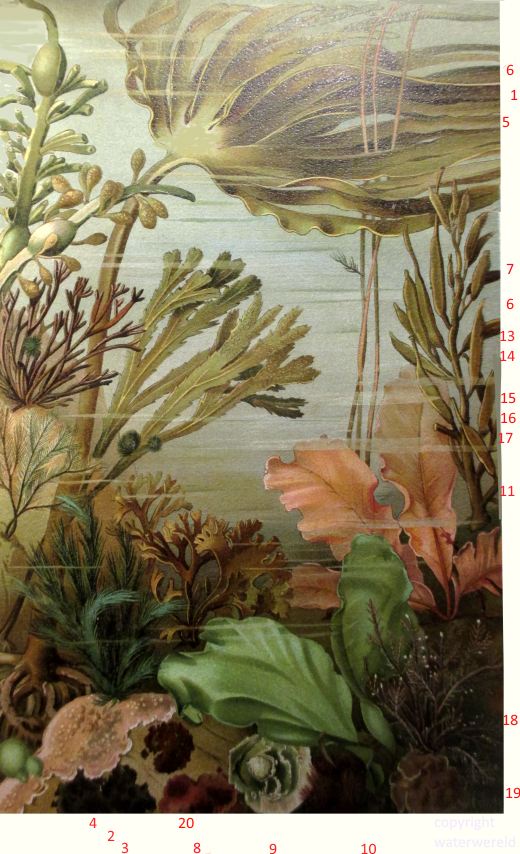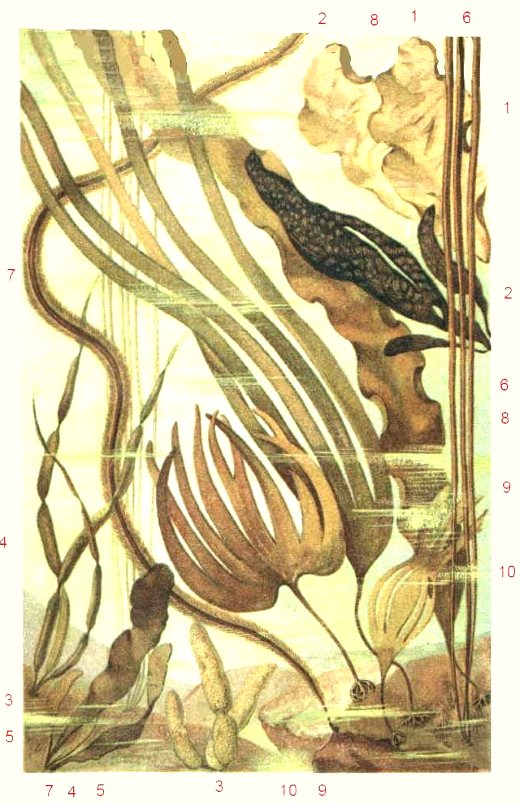Oarweed
Oarweed is a large, about 2 meter long kelp that belongs to the family Laminariaceae. They have a golden-brown colour and have a broad frond with finger-like blades. They grow in the western part of the Atlantic ocean on wave-exposed rocks and rocky seabottoms. Oarweed is also part of the kelpforests that can be found on the rocky bottom of the Northsea. They are firmly attached to rocks with there holdfasts. They have a flexible stipe or stalk and a broad frond with finger-like blades.This small compact kelp is well suited for the harsh wave swept rocky environment, where they it is commonly found.

Seaweed around Helgoland, Northsea.
source: "Die Pflanzenwelt", dr Otto Warburg, 1903.
1 oarweed or Laminaria digitata
2 Lithothamnium Calcareum
3 Pseudolithoderma extensum
4 Tufted Sea Moss or Cladophora rupestris
5 rockweed, Norwegian kelp, knotted kelp or Ascophyllum nodosum
6 dead man's rope or sea lace or chorda filum
7 ectocarpus attached to the sea lace
8 Hildenbrandia rubra
9 Porphyra umbilicalis (this is the Conchocelis rosea, the diploid stage)
10 sea lettuce or ulva lactuca
11 Chaetopteris plumosa
12 Polyides lumbricalis var. fastigiatus
13 cladophora lanosa
14 Acrosiphonia arcta attached on cladophora lanosa
15 toothed wrack or serrated wrack or fucus serratus
16 Elachista fucicula attached on fucus serratus
17 Sea Beech or delesseria sanguinea
18 coral weed or corallina officinalis
19 Lithophyllum incrustans
20 Irish moss or carrageen moss or chondrus crispus
Oarweed and dabberlocks
They grow on the lower shore or are part of kelp forests on the rocky bottom of the sea. Often they grow together with dabberlocks: Dabberlocks on wave-exposed rocks and the oar weed on those rocks that are more sheltered for the waves. Oarweed has a leathery blade that is divided into thin finger-like straps.
Oarweed reproduction
The oarweed, like all the Laminarians, has an sexual and an asexual reproduction phase. The asexual reproduction is the production of progeny without the union of cells. This asexual reproduction is by far the most productiv way of reproduction for the oarweed. Every autumm the oarweed pruduces a massiv amount of spores, about 10 000 million spores. They are produced by the spori: small bubbles on the leaves.
Oarweed and the other marine live
Many seaslugs, worms and small fish use the spaces between the branched dome-shaped holdfast of this plant as a refuge. Sea urchins eat the oarweed.

Seaweed of Northsea and \baltic sea, an illustration by J. Braune, 1905
1 Punctaria latifolia
2 Punctaria plantaginea
3 Asperococcus bullosus
4 Scytosiphon lomentarius
5 Phyllitis Fascia
6 Chorda Filum - Mermaid's Tresses
7 Chorda tomentosa
8 Devil's Apron or Laminaria saccharina
9 oarweed
10 Laminaria hyperborea